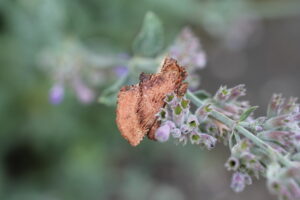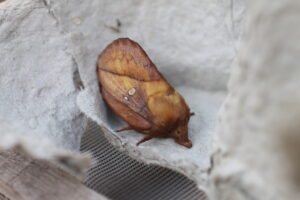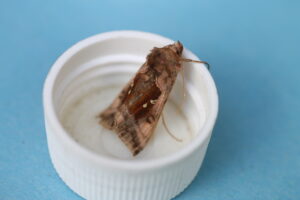3 August 2025
The Real and Fake Deaths of Moths

Every time we peer into our trap I’m overcome with a feeling I can only liken to opening up a rare box of chocolates or trading cards. Left alone with the moths in the shade of the crisp Yorkshire morning air, I’m both delighted and overwhelmingly grateful for the opportunity to handle such wonderful little creatures.
But this morning something strange happened.
While going through my usual routine (carefully extracting and posing the moths in more picturesque locations for the blog), a particularly beautiful Coxcomb Prominent suddenly slipped off my paintbrush and onto the ground. I could only watch in horror as its wings went still and its legs curled up, seemingly dead.
For some reason, this emotionally disturbed me more than I ever imagined an insect could. It’s not uncommon for moths to pass away within the day while we go through our trap. Perhaps it was the Coxcomb’s transition to a sudden stillness when it had moments before commanded such respect with its magnificence that shook me up.

Later that evening, still unsettled, I found myself rereading Virginia Woolf’s short piece “The Death of the Moth.” In the essay, Woolf observes the futile attempts of a small, unidentified moth (although from the limited descriptions, my guess would be a Agriphila straminella) to escape through a closed window before suddenly succumbing to a quick but predictable death.
I was still mourning what short time I’d spent with the beautiful moth when I was interrupted in my thoughts by a fluttering in the corner of my eye. The Coxcomb was alive! The trickster had feigned his death.
The Coxcomb Prominent and Tonic Immobility
This instinctual behavior is known as tonic immobility, or thanatosis, a defense mechanism in which an animal becomes temporarily paralyzed, mimicking death to avoid predation. It’s the act of “playing dead” that I had previously associated more with mammals like opossums, not insects.

Additionally, this response is both reflexive and involuntary. Moths don’t make a conscious choice to activate this survival technique, but rather yield themselves over to a biological protection created to sustain even these tiny seemingly insignificant creatures.
It’s amazing to consider within the larger web of life. Woolf puts it nicely in her essay, describing how these small sprites seem to be spurred into motion by just a “tiny bead” of the same pure life force that runs through all of us, but on its small scale so well illustrates the “true nature of life.” Perseverance against all odds.
The Coxcomb Prominent (Ptilodon capucina) is one such resilient fighter. When handled, it often collapses into stillness, legs splayed, wings tucked. You may think its story is over, but it’s simply waiting for the danger (in this case, my camera) to pass. There’s still more to transpire in its relatively short tale, and it’s determined to see itself through.
The species name Ptilodon comes from the Greek ptilon, meaning “feather”, probably referencing the soft, crest-like tufts on its forewings. The “capucina” part is even more poetic: it refers to a pointed hood or cowl, like those worn by Capuchin monks, echoed in the moth’s distinctive quiff of scales. Interestingly enough, this order of monks are celebratory of death, seeing it more as a transition or passage from earthly life to the new beginning of a more fruitful existence in the company of saints.
Here in the far north, the Coxcomb Prominent appears in just a single generation each summer. It’s active sometimes even by day, and like so many moths, its adult life is short. Just a few weeks to mate, reproduce, and disappear.
At times, I find myself pitying these creatures. Not for their short lives, but for how narrow those lives seem. I’ve always treated summer as a soft intermission: a time of rest, transition, recharging. But for the moths that visit our trap, summer is all there is. These long, drowsy days that stretch before me are their entire existence. The heat, the pollen, the rustle of grass — this is not a season for them. It’s a life.

The Drinker’s Lack of Drinking
With these musings fresh in my mind I began exploring the life of another eye-catching moth that appeared in our trap: the Drinker (Euthrix potatoria).
Named for its caterpillars, which have been seen sipping dew from leaves in the early morning, it’s a stout and woolly adult with a soft brown body and two faint gold spots on its wings.
But here’s the catch: once it becomes an adult, the Drinker stops drinking altogether. In fact, it no longer eats or drinks anything. Like many moths, it doesn’t even have functional mouthparts. Its entire adult life is sustained by the reserves it built up as a caterpillar. From the moment it emerges from its cocoon, the clock is ticking.
There’s something cruelly ironic about the name. The Drinker can’t drink. Its namesake gesture, the dew-sipping of its youth, is a memory sealed inside a body now built for breeding, not feeding.
It’s strange that Mother Nature should put the pressure of the entire continuation of a species on the shoulders of small creatures with only a few short weeks dedicated to a single task.
As I lifted up the little Drinker from our trap, Woolf’s words came back to mind. There’s an “enormous energy of the world” being “thrust into his frail and diminutive body” that we get to witness for so little time.

A Few More Guests from the Trap
Even the most fleeting visitors leave an impression. Here are a few others from our trap this week, each with their own quiet story to tell:
- Mother of Pearl (Pleuroptya ruralis)
- Smoky Wainscot (Mythimna impura)
- Willow Beauty (Peribatodes rhomboidaria)
- Lesser Broad-bordered Yellow Underwing (Noctua janthe)
- Plain Golden Y (Autographa jota)
- Dun-bar (Cosmia trepezina)
Post by Sophia Hernandez (UPenn intern)
Recent Moths
- Rise of the AI Naturalist
- Best Moths for a Haunted Abbey
- The Real and Fake Deaths of Moths
- The Colonizers of Yorkshire
- Glamour in the Dark: Two Newcomers Arrive at Shandy Hall
- 25 July 2023 – Collective Noun for Hawkmoths
- MOTH LIST to August 2023 with links
- 28 July 2023 – TRIPLE New Species Alert!
- 18 July 2023 – A Golden…Plusia!
- 13 July 2023 – Arts and Sciences
- 10 July 2023 – Rise of the Yellow Underwings
- 4 July 2023 – Cold-weather Catch






